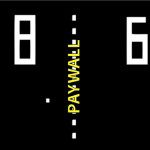Up against the walls
Steve Ladurantaye, media reporter at The Globe and Mail, is blunt: “If we don’t find a way to add revenue, then there’s not going to be a newspaper in five years. This goes for the Globe and everyone else. You can’t lose money forever.”
Among English-language dailies, the Globe was among the first to test the new-to-Canada approach (more than 250 U.S. papers have paywalls); in October it started restricting non-print subscribers to 10 free online articles before charging $20 per month. Sun Media launched a similar model two months later, offering non-subscribers 20 articles per month before charging 99 cents for the first three months, and $5.99 a month after that. Postmedia launched paywalls at four publications in August 2012, and the Star has announced that they plan to launch their own this year.
Metered subscriptions at traditional dailies are still a relatively new concept. While The Wall Street Journal introduced its online subscription model in 1996, The New York Times, which charges subscribers $3.75 to $8.75 (U.S.) per week, depending on the package, set the trend in 2011. It now has close to 600,000 paying customers. “Not everyone is The New York Times,” says Ladurantaye, “but it gives you an idea that it is possible to replace lost revenue with circulation revenue.”
Still, there is risk that digital paywalls in Canada will falter. A 2011 study conducted by the Canadian Media Research Consortium found that 92 percent of Canadians who read news online said they would turn to free news outlets if their preferred newspaper started charging for content. Only 30 percent said they would purchase an online subscription if they had no other options.
Other readers will only pay for online news if publications produce exclusive and desirable content, which Nihir Morzaria, a founder of Toronto-based social-media consulting firm Square Zero Inc., says Canadian publications generally lack. “Newspapers are trying to put up these false gatekeepers for something that is no longer as valuable as they think it is,” says the 29-year-old., who currently gets his news from Canadian online publications, news blogs, and Twitter. (“I think we’re a different generation of readers,” he says. “We don’t look at Twitter and take it as fact. I look at Twitter and there are a hundred different opinions. I know that somewhere in there is the truth.”)
Despite the upsurge in social media as a platform for delivering news, Ladurantaye believes readers will eventually welcome the paywall model. However, he thinks it is still difficult to gauge the initial success of digital subscriptions across Canadian newspapers. If the Globe is looking to the Times as a model, then being candid about its current financial state may be of benefit.
A study that looked into the relationship between readers and the Times’s paywall, published in Cyberpsychology, Behavior, and Social Networking, found that readers were more inclined to purchase an online subscription if the publication was in financial trouble, but less so if a paper announced it was imposing a paywall to improve its content and increase revenue—as the Globe and other newspapers have done.
This is not the only hurdle facing the Globe. Brenda Goldstein, a 39-year-old Toronto native and graduate student residing in New York, digitally subscribes to the Times, but she is unwilling to do the same for the Globe because of what she sees as a noticeable difference in quality. Goldstein reads the Times for its long-form arts and film reporting, as well as its international coverage—areas where she thinks the Globe is lacking. The difference is understandable, seeing as the Times has roughly 1,150 newsroom staff and 24 foreign news bureaus compared to the Globe’s 300 or so staffers and eight foreign news bureaus (its ninth will be opening soon in Latin America).
Instead of attracting new readers, the Star’s strategy is to appeal to existing ones who are already satisfied with the paper’s coverage. “Our message to them will be, ‘Yes, we’re going to charge, but we’re also going to provide a reason for you to want to pay,” says John Ferri, the Star’s digital editor. This means providing added value online, whether through special projects or more investigative pieces. National Post publisher Douglas Kelly agrees with this approach, saying newspapers must think carefully about the online content that is produced. “When someone subscribes to the National Post, I want them to feel like they’re part of something, and that they are getting great benefit from being part of something,” he says.
Some paywall critics think papers should do more than improve content and count on readers to pony up for digital access. For instance, Mathew Ingram, a senior writer at GigaOM, who wrote about the paywall debate in December, proposes that newspapers should adopt a reward system. It’s a concept that has been termed the “reverse paywall,” which would allow devoted and active readers to collect points after engaging with a website and then redeem them for access to exclusive forums or an opportunity to meet one of the paper’s high-profile writers.
No matter the model, paywalls are new territory for Canadian newspapers, and the transition will not be seamless. Ferri says the Star is prepared to shoulder that risk. “The New York Times has led the way, and if that had been a total disaster, perhaps there would be greater hesitation. I think there is a growing sense that there’s a case to be made to the public that quality information requires some investment.”
Robert Dawson, a 27-year-old SEO marketing specialist from British Columbia, isn’t convinced. A skimmer of headlines on news sites to stay up to date, he believes that after years of providing free content, it’s unreasonable for papers to start charging. However, he also allows for the chance that, over time, his initial resistance will fade.
“I never thought I would ever pay for music again, but I do,” he says.
Correction: An earlier version of this story stated that the Globe was the first English-language daily to introduce paywalls when in fact the Globe was only one of the first to do so. Also, it was originally reported that Postmedia publications have not yet introduced their own paywalls and that they have announced their plan to do so this year. Postmedia launched paywalls at four publications in August 2012. We regret the errors.













